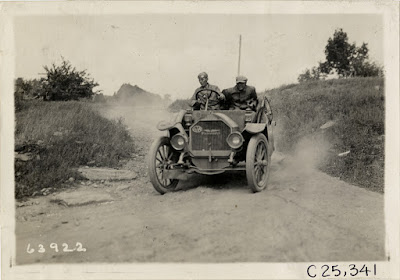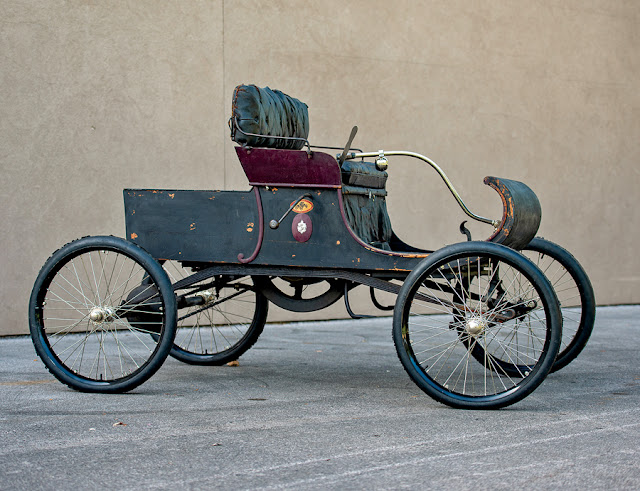Images are from the digital collections, The Detroit Public Library
View of motorists posing in Columbia referee and pacemaker car during the 1910 Munsey Historic Tour. Commercial buildings in background.
In addition to the well-publicized racing events of the period 1895-1910, there were many reliability runs, tours, economy tests, and hill climbs. These events did much to spread the gospel of automcobility and the need for good roads. Such is Munsey's Historic Tour of 1910. It was not over the challenging terrain of the Glidden Tours, but it did provide manufacturers with an opportunity to promote their product, and expose folks in the populous Northeast with automotive possibilities related to space and time. Routes included roads that were constructed by the military during the Revolutionary War. It was about booming the car on the threshold of the coming of the Ford Model T!
Munsey's Magazine sponsored A.A.A. sanctioned tours during the first decade of the 20th century, including the 1910 event, held between August 15 and 30. It was a reliability trial that also served as an event that had "doubtless strong appeal to tourists." There were two kinds of participants: Grade 2, involving timing and technical inspections; Grade 4, with no technical exam or supplementary tests. In many ways it was a party, like the Hemmings Great Race event that is held now every summer, 2020 excluded due to the pandemic. With a historic theme due to the Revolutionary and Civil War sites visited, cities included Philadelphia; Morristown, NJ; West Point, Lenox, MA; NewLondon, CT; Boston; Portsmouth, NH; Bangor, ME; Plattsburgh, NY; Saratoga, NY; Binghamton, NY; Harrisburg, PA; Gettysburg, PA; Baltimore; and Washington.
Final Results
25 Maxwell Walls 3
34 Ford Cheny 7
24 Stoddard Shaaf 12
11 Corbin Baily 16
10 Warren-Detroit Berger 19
6 Washington Arrison 20
5 Washington Carter 26
14 Brush McCoy 26
13 Brush McKinney 33
8 Ford Miller 35
30 Ford Peabody 36
View of motorists in Ford car no. 30 during the 1910 Munsey Historic Tour.
2 Columbia Wagner 40
22 Cino Donnelly 46
31 Kline Fairman 50
17 Engler Frisch 52
21 Ohio Henwood 103
33 Matteson Hall 122
29 Inter-State Dill 131
16 Pierce-Racine Strang 148
View of motorists waving in Pierce-Racine car no. 16 on rural dirt road during the 1910 Munsey Historic Tour.32 Moon Upton 200
23 Staver Knutsen 249
27 Crawford Miller 891
18 Great-Western LaMar 2284
View of motorists in Great Western car no. 18 traveling on rural dirt road during the 1910 Munsey Historic Tour.Krit, Regal, Maxwell, Glide, DNF
View of motorists in Glide car no. 28 traveling on rural dirt road during the 1910 Munsey Historic Tour. "
View of motorists posing in Regal car no. 15 during the 1910 Munsey Historic Tour.
Winners were categorized by value of the cars.
Division 1 -- Brush No. 14
Division 2 -- Ford 34
Division 3 -- Maxwell
Division 4 -- Washington
Division 5 -- Stoddard-Dayton
View of dog sitting next to driver in front seat of car during the 1910 Munsey Historic Tour. Organized by the Munsey newspapers, the endurance contest covered a route through ten states. Stamped on back: "Spooner & Wells, Inc., photographers, telephones 3472-3473 Columbus, 1931 Broadway, New York." Handwritten on back: "Tours--Munsey Historic Tour, 1910."
View of motorist posing in Great Western car no. 18 during the 1910 Munsey Historic Tour. Organized by the Munsey newspapers, the endurance contest covered a route through ten states. Stamped on back: "Spooner & Wells, Inc., photographers, telephones 3472-3473 Columbus, 1931 Broadway, New York." Handwritten on back: "Tours--Munsey Historic Tour, 1910."
View of officials posing with Selden car during the 1910 Munsey Historic Tour. Organized by the Munsey newspapers, the endurance contest covered a route through ten states. Stamped on back: "Spooner & Wells, Inc., photographers, telephones 3472-3473 Columbus, 1931 Broadway, New York." Handwritten on back: "Tours--Munsey Historic Tour, 1910.
View of motorists in Brush car no. 13 and Regal car no. 15 parked in front of house during the 1910 Munsey Historic Tour. Man wearing overalls and two newsboys, carrying Saturday Evening Post bags, stand in front of cars; referee car and American flag on left. Organized by the Munsey newspapers, the endurance contest covered a route through ten states. Stamped on back: "Spooner & Wells, Inc., photographers, telephones 3472-3473 Columbus, 1931 Broadway, New York." Handwritten on back: "Tours--Munsey Historic Tour, 1910.
View of motorists posing in Maxwell car no. 25 in front of the Elton Hotel at Waterbury, Connectict during the 1910 Munsey Historic Tour. Spectators in background. Organized by the Munsey newspapers, the endurance contest covered a route through ten states. Handwritten on back: "#25 Maxwell, Model E touring, driven by Wells. Tours--Munsey Historic Tour, 1910."
View of spectators surrounding motorists in Ohio car no. 21 during the 1910 Munsey Historic Tour. Organized by the Munsey newspapers, the endurance contest covered a route through ten states. Handwritten on back: "#21 Ohio, Model 40A touring, driven by Henwood. Tours--Munsey Historic Tour, 1910."
View of women and man posing in E-M-F press car during the 1910 Munsey Historic Tour. "Official press car, E-M-F '30', Munsey Historic Tour" is lettered on wheel cover. Organized by the Munsey newspapers, the endurance contest covered a route through ten states. Stamped on back: "Spooner & Wells, Inc., photographers, telephones 3472-3473 Columbus, 1931 Broadway, New York." Handwritten on back: "Tours--Munsey Historic Tour, 1910."
View of four officials, one holding an American flag, posing under banner at Harrisburg, Pennsylvania during the 1910 Munsey Historic Tour. Banner reads: "Munsey tourists, Motor Club of Harrisburg, glad-u-kum." Two cars in foreground. Organized by the Munsey newspapers, the endurance contest covered a route through ten states. Stamped on back: "Spooner & Wells, Inc., photographers, telephones 3472-3473 Columbus, 1931 Broadway, New York." Handwritten on back: "Tours--Munsey Historic Tour, 1910."
Rear view of motorists in E-M-F press car traveling on rural dirt road past cornfield during the 1910 Munsey Historic Tour. "E-M-F '30' press car, Munsey Tour" is lettered on back of car. Organized by the Munsey newspapers, the endurance contest covered a route through ten states. Stamped on back: "Spooner & Wells, Inc., photographers, telephones 3472-3473 Columbus, 1931 Broadway, New York." Handwritten on back: "Tours--Munsey Historic Tour, 1910."
























































